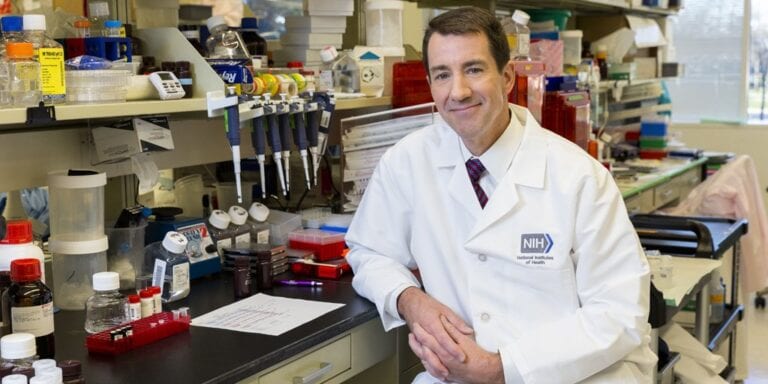by Danny Levine
 Chris Austin describes the National Center for Advancing Translational Sciences, the National Institutes of Health division he directs, as “evangelists for collaboration.”
Chris Austin describes the National Center for Advancing Translational Sciences, the National Institutes of Health division he directs, as “evangelists for collaboration.”
The center, known as NCATS, is charged with transforming the translational process to accelerate conversion of biomedical research into treatments and cures that benefit patients. Austin believes collaboration across diseases is central to that goal.
It’s not hard for rare disease patients and their families to think in terms of their rarity—the unique genetic variation that makes them one in 100,000 or 1 in a million. But embracing that uniqueness can also impede progress by obscuring what they have in common with patients with other rare conditions, whether its similar scientific challenges, overlapping symptoms, or shared biologic pathways underlying their conditions.
“Patients tend to see their differences—the differences between them and other diseases—as paramount,” said Austin. “What we see from the standpoint of looking across all 7,000 diseases is that they have much more in common than what separates them, what differentiates them.”
In fact, Austin says that one of the major lessons in biology and medicine in the last 30 years has been that Mother Nature is the “original repurposer.” Contrary to what he said he was taught during his own training—that each disease is separate, and there are different genes for every function in the human body—genes and pathways are reused over and over in different contexts and to serve different functions.
“What biology is telling us is that there are commonalities among these disorders that we would never suspect clinically,” he said. “If we design our research that way, we will make much more rapid progress because it’s following nature’s guide that we’ve learned over the last number of decades.”
Austin believes the tendency to focus on differences is endemic to the way biomedical research is designed. He notes even NIH is susceptible to the problem as the research is organized in divisions that are akin to medical specialties and can lead to a narrow view of what is and is not within the purview of a given division and reinforce silos that impede progress. As an example, he points to the rare disease myotonic dystrophy, a neuromuscular condition that can affect the skeletal muscle, nerves, heart, and eyes. “Which institute do you apply to and how do you get support?” he asks. “Because everybody’s going to say, ‘Oh, that’s not our problem. It’s their problem.’ And this is a very real issue in the rare disease space.”
That’s a point that Austin and NCATS have taken to heart. Anyone seeking to get funding today through NCATS Rare Disease Clinical Network cannot do so without studying multiple diseases at once through some common organizing principle, such as shared gene networks, cell types, or organelles. “What we see over and over and over again is that by studying multiple rare diseases, at whatever level of organization, we’re able to rapidly apply the lessons in one to the lessons of another because we’re following the lead of Mother Nature and recognizing the commonalities that these have.”
One example of the effort to tackle common problems across disease groups is NCATS ongoing Platform Vector Gene Therapy, or PaVe-GT program, a pilot project that seeks to increase the efficiency of clinical trial startup by using the same gene delivery system and manufacturing methods for multiple rare disease gene therapies. The program is working ton using these common elements for gene therapies across four different diseases. Ultimately, the program hopes to make available a set of vectors that can be used across diseases along with program results and regulatory documents that would allow gene therapy developers to leverage that work and bypass the time and investment needed to do much of the preclinical work and regulatory work required by plugging in the necessary genetic material to address a specific condition.
Austin said he encourages patient groups and scientists to look for connections with other conditions to recognize commonalities and find opportunities to collaborate and to do so as broadly as makes biological sense. He said that once a patient advocacy group understands what the fundamental defect—the biochemical defect, genetic defect, cellular defect, whatever it is in their disorder—that provides a means for finding other disorders that share that commonality, whether its a gene dysfunction, a pathway dysfunction, or a cell type dysfunction. To that end, he sees RARE-X as a promising development to drive collaboration and accelerate science.
“The people and organizations in RARE-X are top-notch,” he said. “Their stated goal to empower broad data sharing across the rare disease community is important and would advance collaboration and the finding of commonalities among diseases, both of which would improve the pace of progress in rare disease diagnosis and treatment.”

Stay Connected
Sign up for updates straight to your inbox.
